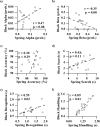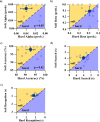Using sensory discrimination in a foraging-style task to evaluate human upper-limb sensorimotor performance
- PMID: 30967581
- PMCID: PMC6456599
- DOI: 10.1038/s41598-019-42086-0
Using sensory discrimination in a foraging-style task to evaluate human upper-limb sensorimotor performance
Abstract
Object stiffness discrimination is fundamental to shaping the way we interact with our environment. Investigating the sensorimotor mechanisms underpinning stiffness discrimination may help further our understanding of healthy and sensory-impaired upper limb function. We developed a metric that leverages sensory discrimination techniques and a foraging-based analysis to characterize participant accuracy and discrimination processes of sensorimotor control. Our metric required searching and discriminating two variants of test-object: rubber blocks and spring cells, which emphasized cutaneous-force and proprioceptive feedback, respectively. We measured the number of test-objects handled, selection accuracy, and foraging duration. These values were used to derive six indicators of performance. We observed higher discrimination accuracies, with quicker search and handling durations, for blocks compared to spring cells. Correlative analyses of accuracy, error rates, and foraging times suggested that the block and spring variants were, in fact, unique sensory tasks. These results provide evidence that our metric is sensitive to the contributions of sensory feedback, motor control, and task performance strategy, and will likely be effective in further characterizing the impact of sensory feedback on motor control in healthy and sensory-impaired populations.
Conflict of interest statement
The authors declare no competing interests.
Figures














References
-
- Srinivasan, M. A. & Lamotte, R. H. Tactual Discrimination of Softness. Neurophysiology73 (1995). - PubMed
-
- Johansson RS, Flanagan JR. Tactile Sensory Control of Object Manipulation in Humans. Senses A Compr. Ref. 2010;6:67–86.

